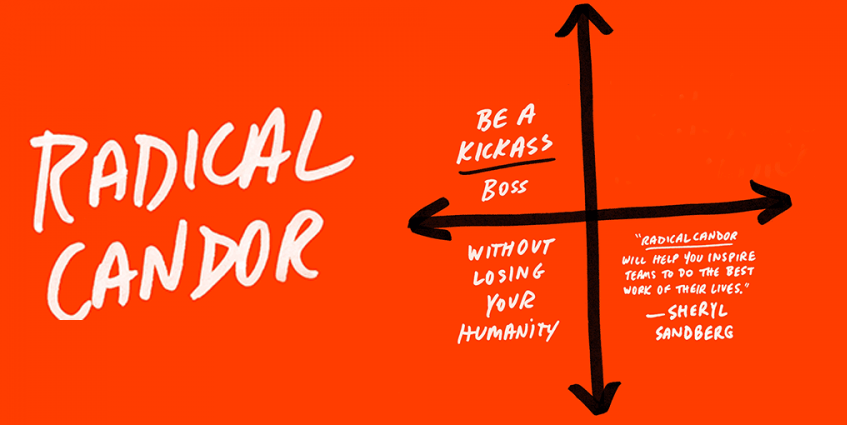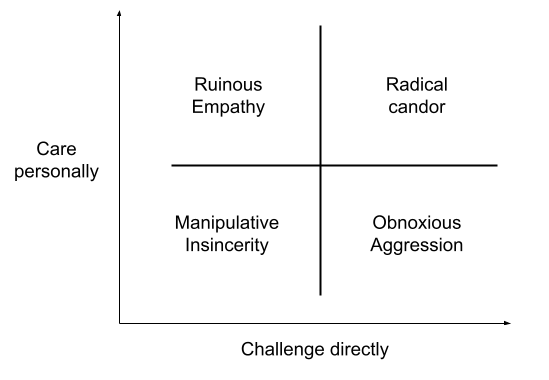Radical Candor by Kim Scott heavily influenced my communication style and the way I build communication in my teams. Radical Candor is not so radical as it sounds, though. In essence, it cuts off all the sugarcoating, awkwardness, and harshness, leaving good and effective relationships. This article is not a retelling of the original book, it is a summary of the most important things that I learned and applied from it.
- Know Your Rock and Superstars
- Praise in Public, Criticize in Private
- Care and Challenge
- Summary of Radical Candor
I consider team communication “good” when it leads to achieving team goals and minimises risks of not achieving goals. People are afraid to raise problems? Shouting and mocking at individual contributors “to keep troops in shape”? Constantly smiling and funny manager that gives you terrible scores on performance review without any warning? All of this destroys software engineering teams and companies. Radical Candor outtakes below help me in building good communication.

Know Your Rock and Superstars
Radical Candor splits people in two categories, based on how they work and approach tasks. This classification, as any classification, is never precise and everyone is both Rock and Super star in different moments of time in different proportions.
Rock stars are stable, reliable, they do what they are asked to and are responsible for the majority of teams output in terms of volume (story points, for example, as they have high personal efficiency). Rock stars rarely propose radical changes, they rarely push their vision, and they tend not to involve too much into communication.
On the contrary, Super stars are about shooting for the stars. They are usually behind the most important team outcomes (see the difference between outputs and outcomes), they are constantly searching for better, faster, and more effective solutions to use. Superstars have a more solid vision of how things should work, they are eager to defend and to push the vision. At the same time, they might not be as predictable and reliable as Rock stars, as sometimes they are carried away by their ideas or side track research.
One of the best examples of Rock and Super stars is Steve Wozniak and Steve Jobs.

The key outtake is that successful managers combine both types in their teams, so the team is both predictable and impactful. Know your team, let them choose what and how they want to work, align it with company goals to achieve greatness.
Praise in Public, Criticize in Private
We are all people. I have never met anybody who enjoys being criticized in public, even if it is deserved. However, I met quite a few managers who liked to have public “shaming sessions”. The story of those managers was not so bright, honestly.
Criticizing in private is good piece advice for life in general. Public critique does not help anybody – if the person is motivated by fear of public criticism, do you really want to work with them at all? The response to public shame is partially related to society, check out this post on difference in shame and guilt societies.
Avoid public critique as much as possible, unless it is a learning experience for the entire team without shaming the fire starter. Be aware that ruining relationships is much easier than building it afterwards. Talking directly one to one is the best option when you have questions or complaints.
Care and Challenge
Genuinely care about people and challenge them directly. What does it mean?
Let’s break down the relationships into two dimensions – how much you care about a person and how much you want them to grow.
You may not care about them, but push them to grow. This is going to be aggressive and harsh.
You may care about them, but not push them forward. This is going to be comfortable and calming degradation.
You may not care and not push forward. This is even more ugly, as the person will feel terrible and used, and they will not grow in any way.
You may care, but challenge and push at the same time. Be a mother who cares, and a father who challenges at the same time (slipping a bit of Erich Fromm into this).

I used to be too empathetic and not challenging, and this never worked. I saw other managers practicing other styles and the radical candor is always the most efficient way. The border where you start caring and challenging depends on many factors, including the personality of manager, team member, culture, corporate policies. However, as a manager, never stop caring and challenging your team.
Summary of Radical Candor
The book is for those who value and understand why it is good to have good relationships in the team and the company. The communication style depends on the personality of the actors, but it can always be improved. Dive deeper into the Radical Candor book if you are interested!
Make sure that your team feels that you care about them. At the same time, challenge them, so everybody can grow and reach new heights.